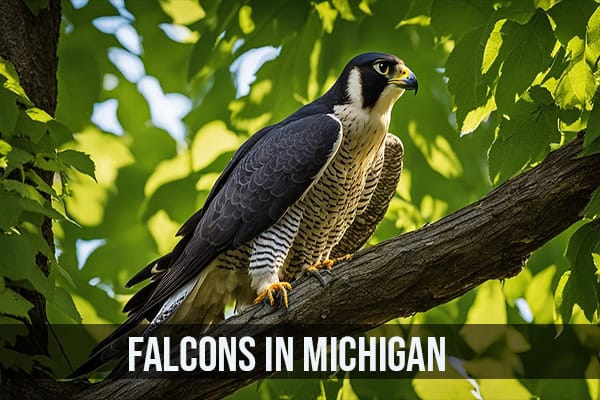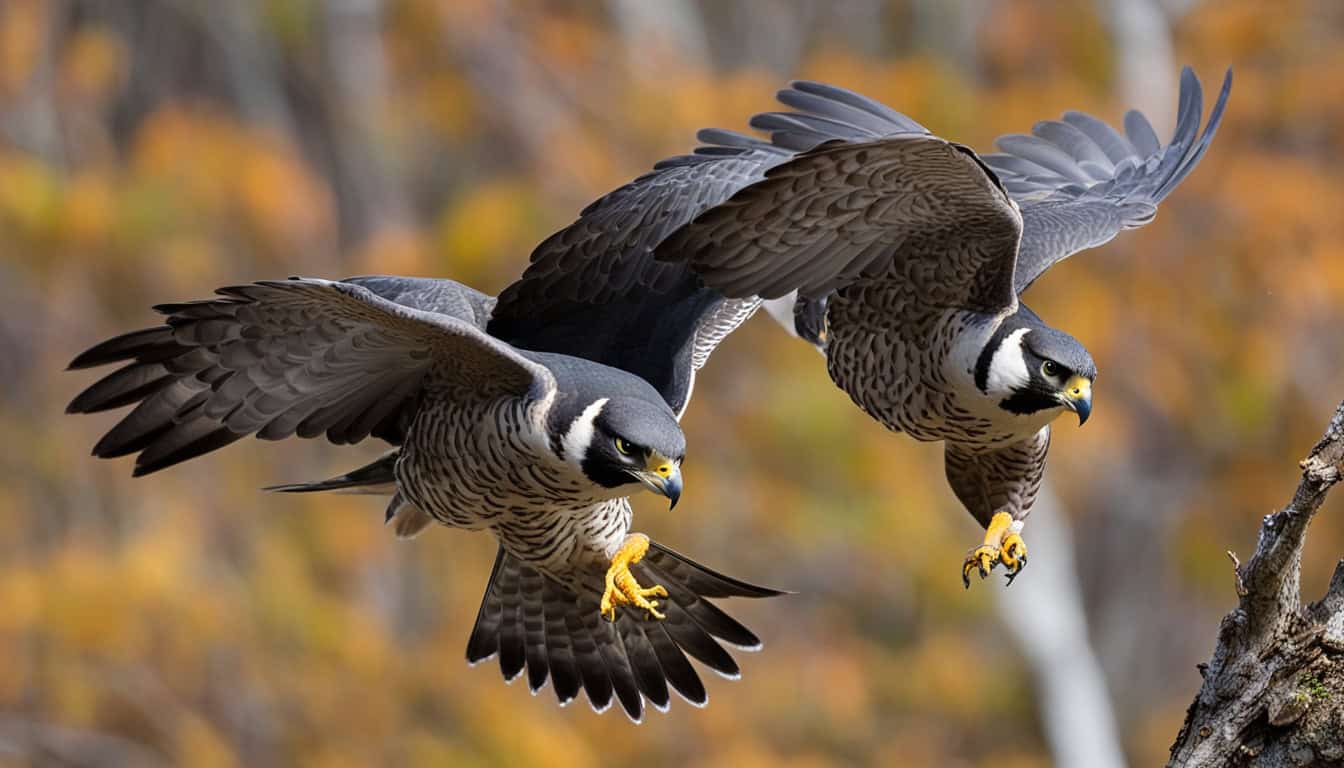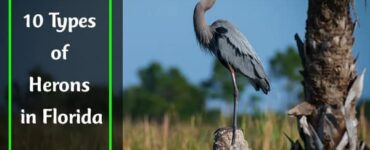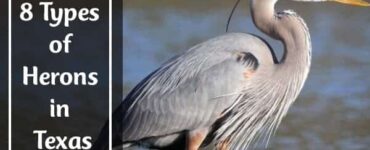Have you ever wondered about falcons in Michigan? Known for their speed, agility, and hunting skills, these birds are truly amazing. Michigan is home to a range of falcons, from the well-known Peregrine Falcon to the fierce American Kestrel. But what makes these birds so special? Let’s explore the world of Michigan’s falcons. We’ll look at what makes them unique, how they act, and what’s being done to protect them.
Magnificent Birds of Prey Soaring Over the Great Lakes State
The Peregrine Falcon is a stunning bird of prey. It’s famous for its lightning-fast speed and how it hunts while flying. Found nearly everywhere on Earth except Antarctica, the Peregrine Falcon is truly global.
In North America, you can spot the Peregrine Falcon in various places. It might be near the coast’s cliffs or high up in city skylines. Its sleek, blue-gray feather coat and unique black “mustache” stand out.

To win a mate, the male Peregrine Falcon does impressive air shows. These include high-speed chases and daring dives. They generally mate for life and return to their nest every year.
The American Kestrel is small yet mighty. It’s known for its bold hunting skills and beautiful look. This bird is common across North America and in Michigan.
It shines with a rusty back, blue-gray wings, and a striking face pattern. During mating season, males soar in stunning displays to find a partner. After choosing a mate, the female picks a place to nest, often a tree cavity or a human-made nest box.
Identifying Falcons in Michigan
1. Peregrine Falcon: Physical Features and Markings
The Peregrine Falcon is big, with a 41-inch wingspan, similar to a crow. Females are slightly bigger than males. Look for a blue-grey back and a black head. Their underparts are white with bars.
Juveniles have lots of markings. Instead of bars, they have streaks on their breast. This makes them look like Merlins, another type of falcon.
2. American Kestrel: Striking Plumage and Appearance
The American Kestrel stands out with its bright colors. It has a rusty back and tail, blue-gray wings, and a face pattern of white and black. Both males and females sport these colors, but females are usually bigger.
Breeding and Nesting Habits
Peregrine Falcon: Courtship Displays and Nest Sites
In the spring, male Peregrine Falcons show off in the sky to win over a female. They zoom fast, dive sharply, and twist in the air. This proves they’re strong and skilled hunters.
If the female likes what she sees, she joins in. Together, they perform amazing flights. They circle and dive, flying as one.
Peregrine Falcons pick spots like cliffs or human structures for their nests. These homes, known as “scrapes,” are made from gravel, dirt, and such. They’re also lined with things like feathers, grass, or moss.
American Kestrel: Monogamous Pairs and Nesting Behavior
American Kestrels also come together in spring, staying faithful. The male chooses a place and then shows off in the air to get a partner. After pairing, the female picks a spot. This might be a tree hole or a special man-made box. They build their nest there with twigs, grass, and feathers.
Hunting Strategies and Diet
Peregrine Falcon: Speed and Aerial Hunting
The peregrine falcon is famous for its top speed and skill at hunting in the air. They can fly as fast as 200 miles per hour when they dive. This makes them the swiftest bird on the planet. When they hunt, they often grab their prey while flying, using their sharp claws and a quick bite to kill. They can also catch prey after a chase on the same level. Their main meals are medium-sized birds like doves, pigeons, and waterfowl. But they’re also known to tackle larger birds and even some small mammals, like bats, for food.
American Kestrel: Diverse Diet and Foraging Tactics
The American kestrel is a small falcon that eats various things, including insects, small mammals, and birds. What it eats changes with the season and what’s available. In summer, it’s all about insects like grasshoppers and beetles, along with reptiles and amphibians. As days get shorter, it adds small birds and mammals to its diet. Hunting usually involves perching and looking around, or flying in one spot to spot prey below, then swiftly diving to snatch its meal with its sharp claws.
Falcons in Michigan: Conservation Efforts and Success Stories
The Peregrine Falcon used to live across the world. But, it almost disappeared in the 20th century because of DDT pesticides. These pesticides made their eggs too thin, which hurt baby falcons. This problem caused many Peregrine Falcons to become endangered.

In the 1970s, people started working hard to save them. They stopped using DDT and started breeding falcons in captivity. Then, they released these falcons back into the wild. They made sure to keep an eye on their progress. Over time, thanks to these actions, falcons have come back in many places, including the US and Canada.
In Michigan, falcons have gone from being very endangered to just at risk. In 2006, there were 13 peregrine falcon pairs in Michigan. Ten of them had babies that year. Falcons now like to build their nests on tall buildings and bridges.
A project to tag falcons started in the early 2000s. This lets people follow where the birds go. Thanks to saving laws and stopping DDT, Peregrine Falcons are doing much better. But, they still need our help to stay healthy and safe in Michigan.
Peregrine Falcon: From Endangered to Recovered
Captive Breeding and Reintroduction Programs
In the 1970s, efforts began to save the Peregrine Falcon from becoming extinct. They banned DDT, which was a huge help. Also, they started programs to breed Peregrine falcons in captivity.
These birds were then released back into the wild. The goal was to bring them back to places where they had disappeared. These efforts have successfully brought back the Peregrine Falcon. Many countries, the US and Canada included, no longer consider it endangered.
Ongoing Monitoring and Protection
Even with a huge comeback, Peregrine Falcons still face dangers. Some dangers include losing their homes and being bothered. Because of this, people are working hard to keep this bird’s population strong.
Michigan, for example, is aiming for at least 10 breeding pairs of Peregrine Falcons. They also team up with regular people to keep an eye on these birds. This helps a lot in making sure Peregrine Falcons stay safe.
American Kestrel: Declining Populations and Nest Box Initiatives
The American Kestrel faces problems in North America. Its numbers are dropping. This could be because of habitat loss, pesticides, and competition from other species. These include European Starlings and House Sparrows. To help them, we’re working on better habitats and nest boxes.
In Michigan, American Kestrels are finding homes in cherry orchards’ nest boxes. This has helped lower the amount of birds eating the fruit. Over 80% of the kestrel boxes were used in Grand Traverse. But only about 33% were used in the blueberry fields of southwest Michigan. This shows a difference in success.
Protecting crops from birds in Michigan is very important. It can save growers a lot of money each year. The drop in American Kestrel numbers shows we need to keep working. By using nest boxes and other solutions, we hope to support these beautiful birds.
Megan Shave and her team helped set up nest boxes with cherry growers. This work is saving a lot of money and helping the economy. By protecting cherries, new jobs are being created. This could bring millions more to Michigan over five years.
The nest box project has now moved to blueberry farms. They’re studying how fruit growers across the country can benefit. They compare farms with kestrel nest boxes to those without. This shows using American Kestrels for bird control works.
Michigan is an important place for cherries, making most of the tart cherries and many sweet cherries in the U.S. The research shows putting up nest boxes is good for the economy. It’s a smart way to protect fruit and benefit the area.
Read Our Previous Articles:
Falcon Watching and Citizen Science in Michigan
Birdwatchers and citizen scientists are key in keeping an eye on falcons in Michigan. The U.S. Fish and Wildlife Service and others have stepped up efforts to watch over these birds. They do this by looking out for falcons during the day, from late March to late August every year.
To help out, you can join in by watching falcons in your area or through migration counts. Or by taking part in bird surveys. Sharing your falcon sightings on eBird is another way to join in. This platform lets people help by adding their bird observations.
The work of citizen scientists in Michigan has greatly helped track the recovery of birds like the Peregrine Falcon. This species was endangered but has bounced back, thanks to conservation work. Your help in watching, counting, and entering sightings makes a big difference in protecting Michigan’s falcons.




Add comment